Sarkar N. (ed.) Human-Robot Interaction
Подождите немного. Документ загружается.

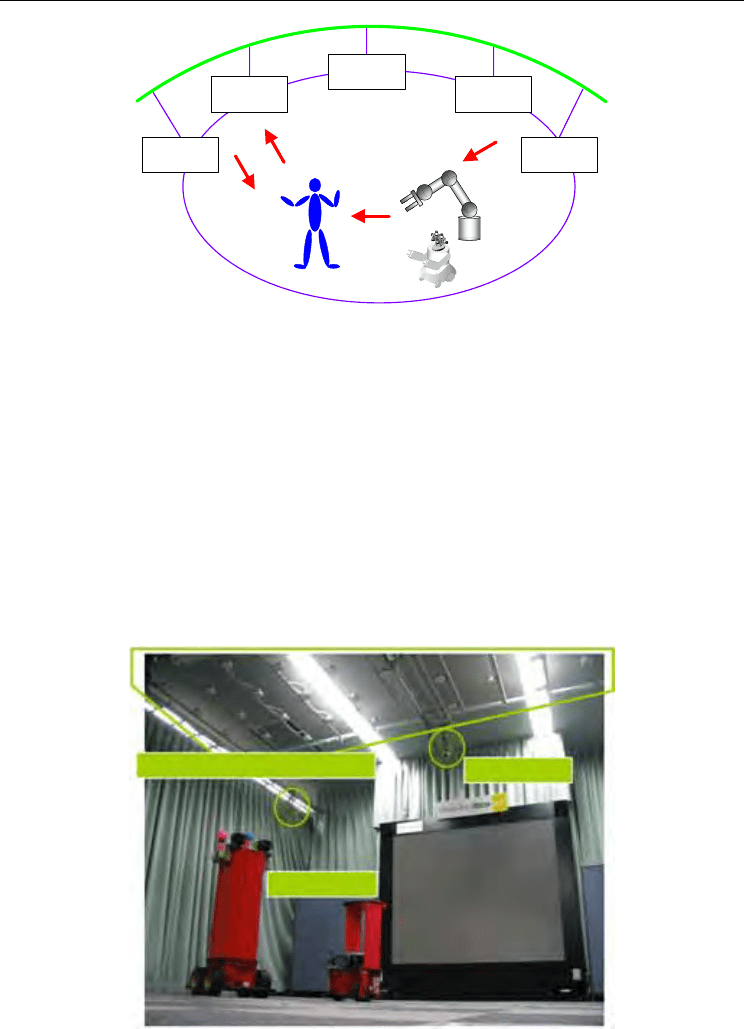
Intelligent Space as a Platform for Human Observation
311
Network
Space
Human
Agent
(Robot)
Non physical
services
Monitoring,
Comprehension
Physical
Services
Information,
Control
DIND
DIND
DIND
DIND
DIND
Figure 1. Concept of Intelligent Space
2.2 Configuration of Intelligent Space
Fig. 2 and 3 show a picture and configuration of the implemented iSpace. ISpace is currently
implemented in a laboratory environment which has an area of about 5 meters × 5 meters. In
this research, six CCD cameras and a 3D ultrasonic positioning system are used as sensors of
DIND. The cameras are connected in pairs to computers with two video capture boards. As
a result, each camera DIND can get the three dimensional position of objects by stereo
vision. The 3D ultrasonic positioning system involves 96 ultrasonic receivers installed on the
ceiling. This system can measure the three dimensional position of an ultrasonic transmitter
to an accuracy of 20-80 millimeters using triangulation method. Moreover, a differential
wheeled robot is used as mobile agent. For estimating the position and orientation of the
robot, two ultrasonic transmitters are installed on the top of the mobile robot. The mobile
robot is also equipped with a wireless network device to communicate with iSpace.
Ultrasonic 3D Positioning System
CCD Cameras
Mobile Robots
Figure 2. Sensors and mobile agents
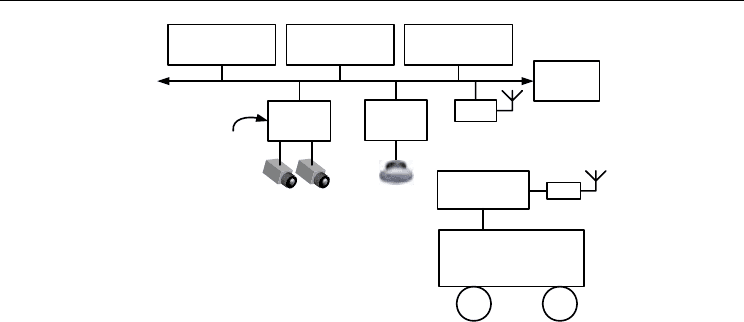
Human-Robot Interaction
312
Firewall
Gateway
DIND
Windows
Pan-Tilt-Zoom
CCD Camera
Private TCP/IP LAN
Wireless LAN
Base Station
DIND
Linux
Ultrasonic
Positioning
System
...
...
Position Server
Linux
Linux
Robot Server
Mobile Robot Platform
Sonar, Bumper
Motor Control
RS232C
Robot Controller
Linux
Path Planner
Linux
Color Based
Visual Tracking
Module
Figure 3. Implemented configuration
3. Observation of Human Walking for Mobile Robot Navigation
3.1 Proposed Method and Related Work
In this research, we focus on human observation for mobile robot navigation since moving
though the space is one of the most basic functions for mobile robots. Related to this, some
researchers have utilized human walking for mobile robot navigation and control.
In (Appenzeller, 1997), it was proposed that the area where human walks is also traversable
for mobile robots and described a system that can generate topological maps for mobile
robots by measuring the positions of people in iSpace. The same idea is found in (Tanaka et
al., 2003) where mobile robot on-board sensors were used for observation. However, these
maps are built based only on the positions of humans. This means that mobile robots can
move along a safe path, but since the generated path doesn’t reflect the human motion,
robot’s movement may interfere with humans’.
To the contrary, by avoiding the regions which have a high probability of the presence of
people, a path which minimizes the expected travel time (sum of the travel time and the
time needed for passing a person on the way) or probability of encountering people was
generated in (Kruse & Wahl, 1998). However the authors utilized the observation result of
the past and didn’t take into account the current positions of people. As a result, mobile
robots generate an inefficient path in case that no person exists between the start and the
goal point. Furthermore, their motion may be unnatural for humans since the mobile robots
move in the area where human doesn’t walk. So, some researchers aim to navigate a mobile
robot by predicting a future motion of currently tracked human from the history of the
observed paths in the environment and changing the motion of the mobile robot only when
it is needed (Bennewitz et al., 2005; Foka & Trahanias, 2002; Rennekamp et al., 2006;
Vasquez et al., 2004). This approach is efficient because with the obtained path the mobile
robots avoid unnecessary contact with people. However, these researches mainly focus on
the prediction method and the initial path planning of the mobile robots in human-robot
shared space isn’t taken into account.
Therefore, in this paper, we consider the method for planning an efficient and natural path
which is suitable for mobile robot navigation in a living environment based on observation
of human walking.

Intelligent Space as a Platform for Human Observation
313
When a person moves with purpose, the start and the goal point have meaning for the
desired action and can be regarded as important points in the space. We also consider that
paths frequently used by human are efficient and contain the “rules of the environment.” So,
we extract important points from the observation and average the human walking paths
between two important points to get frequently used paths. The averaged paths are utilized
as paths of the mobile robots. By using the important point based paths, mobile robots can
choose to explore the parts of space that are meaningful to humans. Furthermore, since such
a path is similar to the human chosen path, it is especially useful for robotic guidance
applications. By comparing currently observed paths and the frequently used paths, we can
combine a motion generation method based on the prediction of the human walking.
3.2 Acquisition of Human Walking Paths
We use vision sensors for tracking so that humans don't have to carry any special devices,
e.g. tags for ultrasound system. In the tracking process, the position and field of view of all
cameras are fixed. The intrinsic and extrinsic camera parameters are calculated beforehand
using a camera calibration method (e.g. (Tsai, 1987; Zhang, 2000)).
In each DIND, human tracking based on background subtraction and color histogram is
performed, and the three dimensional position is reconstructed by stereo vision. Then the
position information of humans is sent to the position server. The position server also
synchronizes the actions of DINDs.
In the position server, fusion of information is done in order to acquire global information
about the whole space. Each position sent from DINDs (x
send
, y
send
, z
send
) is compared with
positions stored on the server (x
i
, y
i
, z
i
), (i=1, 2, …, n). Let ǔ
x
, ǔ
y
, ǔ
z
, ǂ
x
, ǂ
y
and ǂ
z
be positive
constants. If the sent information satisfies
|x
send
- x
i
| < ǔ
x
and |y
send
- y
i
| < ǔ
y
and |z
send
- z
i
| < ǔ
z
, (1)
the position information is set to the sent information which has the minimum value of
ǂ
x
(x
send
- x
i
)
2
+ ǂ
y
(y
send
- y
i
)
2
+ ǂ
z
(z
send
- z
i
)
2
. (2)
In case no stored information satisfies (1), it is recognized as a new object's information.
Then the position server creates a new ID and stores the information. The ID assigned to the
new tracked human is sent back to the DIND. After that, if the DIND can continue to track
the human, the DIND sends the ID as well as position information to the position server. In
this case, the position server identifies the object based on ID and (1), and doesn't search all
information. If more than one DIND can observe the same human, the mean value is used to
determine the position of the human.
To avoid increasing the number of objects stored on the server as time passes, the
information of a human who is not detected for a certain period of time (5 seconds in this
research) is erased.
A human walking path is generated by projecting the time-series data of a human to the x-y
(ground) plane. However human often stays in the same place. Therefore, the tracking
system has to determine if the human is walking or not because human never completely
stops in such a situation.
In order to do this, we define the absolute value of the velocity in the x-y plane v
xy
, and x
and y components of the mean position x
mean
, y
mean
in the past k steps:

Human-Robot Interaction
314
()()
t
yyxx
v
Ʀ
2
1tt
2
1tt
xy
nownownownow
−−
−+−
=
, (3)
¦
¦
−=
−=
=
=
now
now
now
now
Ʀ
tmean
Ʀ
tmean
1
,
1
t
tktt
t
tktt
y
k
y
x
k
x
, (4)
where Ʀt is the sampling rate, x
t
and y
t
is the position of human at time t in x and y
components, respectively, and t
now
is the current time. If v
xy
is lower than a given threshold
ǔ
v
for k consecutive time steps, the system judges that the human is stationary at (x
mean
,
y
mean
). Once the static condition is satisfied, the human is considered to stay there until
he/she gets more than a certain distance ǔ
d
away from (x
mean
, y
mean
).
3.3 Extraction of Frequently Used Paths
The extraction of frequently used paths from the obtained walking paths is done by three
steps: 1) extraction of important points, 2) path clustering and 3) path averaging. The reason
not to do path clustering directly but to extract important points at the beginning is that
path clustering needs appropriate parameters to be set for every situation, which is more
difficult than extraction of important points.
First, we explain the extraction of important points. In this research, we define important
points as entry/exit points which are useful for mobile robots to move from one area to
another, and stop points which are helpful when mobile robots approach humans to
provide services. The entry/exit points are extracted based on the points where the tracking
system finds new objects or loses objects. On the other hand, the stop points are extracted
based on the points where the static condition (section 3.2) is satisfied. These candidates for
entry/exit and stop points are grouped by hierarchical clustering and considered as
important points if a cluster which consists of many points is formed. We use Euclidean
distance in the x-y plane as measure of distance between the points. The clustering process is
continued until the distance between clusters exceeds a certain value ǔ
c
because it is hard to
determine how many important points are in the environment.
In the next step, for all combinations of two important points, we consider paths which have
these points for start and goal points. If there is more than one path that connects the two
points path clustering is performed.
We use a hierarchical clustering method based on the LCSS (Longest Common
Subsequence) similarity measure (S1 similarity function presented in (Vlachos et al., 2002)).
There are several advantages in using this method. First, it can cope with trajectories which
have different length, different sampling rates or different speeds. Second, it is robust to
noise compared to Euclidean distance or DTW (Dynamic Time Warping) distance. Third, it
can be calculated efficiently by using a dynamic programming algorithm.
Let A and B be two trajectories with n and m data points respectively, that is A = ((a
x,1
, a
y,1
),
…, (a
x,n
, a
y,n
)), B = ((b
x,1
, b
y,1
), …, (b
x,m
, b
y,m
)). The LCSS models measure the similarity
between A and B based on how many corresponding points are found in A and B. Similar to
DTW method this model allows time stretching so the points which has close spatial
position and the order in the path can be matched. The best match obtained under the

Intelligent Space as a Platform for Human Observation
315
condition that the rearranging of the order of the points is prohibited is used for calculation
of the similarity. This is formulated as follows. Let Head(A) and Head(B) be trajectories with
n-1 and m-1 data points expressed as Head(A) = ((a
x,1
, a
y,1
), …, (a
x,n-1
, a
y,n-1
)), Head(B)= ((b
x,1
,
b
y,1
), …, (b
x,m-1
, b
y,m-1
)). Given an integer Dž (parameter of time stretching) and a real number dž
(threshold for matching two values), LCSS
Dž,dž
(A, B) is defined as:
()
()
() ()()
()
()() ()()
()
()
°
°
°
°
¯
°
°
°
°
®
≤−<−<−
+
=
otherwise
,LCSS,,LCSSmax
andand
,LCSS1
emptyisor
0
,LCSS
eDž,eDž,
my,ny,mx,nx,
eDž,
eDž,
BHeadABAHead
Džmndžbadžba
BHeadAHead
BA
BA
. (5)
The ratio of the number of corresponding point to the number of points in the shorter path
is defined as the similarity. As the similarity has a value of 0 (dissimilar) to 1 (similar), the
distance between A and B is defined as 1-(similarity). So a distance function D(Dž, dž, A, B) is
expressed as follows:
()
()
()
mn
BA
BAdžDžD
eDž
,min
,LCSS
-1,,,
,
=
. (6)
Using the distance function (6), clustering of paths can be performed.
Finally, clustered paths are averaged to extract frequently used paths in the environment.
An averaged trajectory is derived from corresponding points between two trajectories,
which can be obtained from the LCSS similarity measure. The middle point of
corresponding points is used to acquire averaged paths.
4. Mobile Robot Navigation Based on Observation of Humans
4.1 Model of the Mobile Robot
We consider a two-wheeled mobile robot model shown in Fig. 4. Let O-
w
x
w
y be the
coordinate system fixed to iSpace (world coordinate system) and C-
R
x
R
y be the coordinate
system fixed to the mobile robot (robot coordinate system). The position and orientation of
the mobile robot are denoted by (x, y, lj) in world coordinate system. The control inputs for
the mobile robot are the translational velocity v and rotational velocity ǚ. Here, the
kinematic model for the mobile robot is expressed as follows:
»
¼
º
«
¬
ª
»
»
¼
º
«
«
¬
ª
»
»
¼
º
«
«
¬
ª
=
ǚ
v
lj
lj
lj
y
x
10
0sin
0cos
. (7)
In addition, two ultrasonic transmitters used with the ultrasonic positioning system are
installed on the mobile robot. Their coordinates in the robot coordinate system are (L
1
, 0), (-
L
2
, 0).
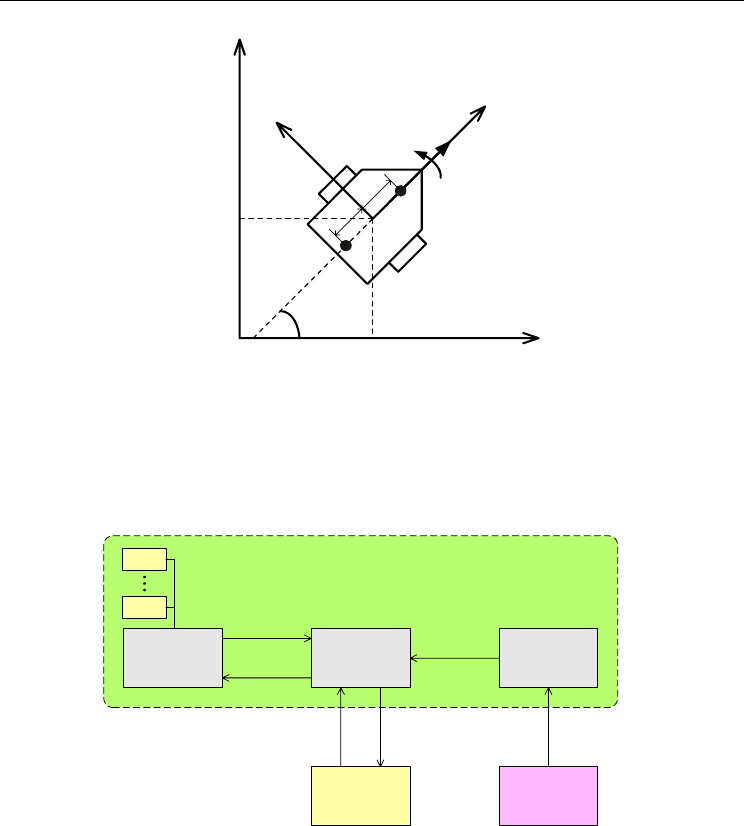
Human-Robot Interaction
316
W
x
W
y
O
x
y
R
x
R
y
ǰ
v
ȁ
Mobile Robot
C
L
2
L
1
Ultrasonic
Transmitter
Figure 4. Model of a mobile robot
4.2 Navigation System
Fig. 5 shows the mobile robot navigation system. This system consists of the position server,
the robot controller and the path planner. As shown in Fig. 3, each module is connected
through the TCP/IP communication network. These modules are described below.
Control inputSensor readings
Position
Goal point
Request
Path
Mobile
Robot
Robot
Controller
Path
Planner
Position
Server
Intelligent Space
User
DIND
DIND
Figure 5. Navigation system
1. Position Server: The position server stores the position information of the mobile robot
obtained by DINDs. Unlike in the case of human, ultrasonic transmitters can be
installed on the mobile robot in advance. Therefore, the position of the mobile robot is
measured by the 3D ultrasonic positioning system.
2. Robot Controller: The robot controller estimates the position and orientation of the
mobile robot based on data from iSpace (3D ultrasonic positioning system) and mobile
robot (wheel encoder). The dead reckoning method is frequently used to determine the
position of the mobile robot. However, it has cumulative error because of slipping
motion of wheels. On the other hand, localization using the 3D ultrasonic positioning

Intelligent Space as a Platform for Human Observation
317
system shows high accuracy, but it suffers from errors, such as failure to receive the
ultrasonic wave from the transmitter. So, those two measurement data are fused using
EKF (Extended Kalman Filter) to minimize the position error.
In order to implement the EKF, the model of the system has to be developed.
Discretizing (7), we obtain the following state equation:
kk
1k
1k1k
1k1k
k
k
k
Ʀ
sinƦ
cosƦ
w
tǚlj
ljtvy
ljtvx
lj
y
x
W+
»
»
»
¼
º
«
«
«
¬
ª
+
+
+
=
»
»
»
¼
º
«
«
«
¬
ª
−
−−
−−
, (8)
where x
k
, y
k
and lj
k
denote position and orientation of the mobile robot at time k, Ʀt is
the sampling rate, v and ǚ are the translational velocity and the rotational velocity
obtained from encoders, respectively. See (Welch & Bishop, 1995) for other symbols.
The observation equation is expressed as follows:
kk
kk
kk
zps
zps
sin
cos
v
ljLy
ljLx
y
x
V+
»
¼
º
«
¬
ª
+
+
=
»
»
¼
º
«
«
¬
ª
, (9)
where (x
zps
, y
zps
) is the position of the ultrasonic transmitter in world coordinate system,
and L equals L
1
or -L
2
depending whether the signal is from the front or rear
transmitter.
Linearizing the state equation, Jacobian matrix
A
k
is obtained:
»
»
»
¼
º
«
«
«
¬
ª
−
=
−
−
100
cosljƦ10
sinljƦ01
1k
1k
k
tv
tv
A
. (10)
We consider that the noise on the encoder is white noise with a normal distribution.
Here, Jacobian matrix
W
k
is expressed as follows:
»
»
»
¼
º
«
«
«
¬
ª
−
−
=
−
−
t
ljt
ljt
Ʀ-0
0sinƦ
0cosƦ
1k
1k
k
W
. (11)
From the observation equation, Jacobian matrix
H
k
is
»
¼
º
«
¬
ª
−
=
k
k
k
cos10
sin01
ljL
ljL
H
. (12)
Jacobian matrix
V
k
is determined as follows:
»
¼
º
«
¬
ª
=
10
01
k
V
. (13)
In this research, we assume the process noise covariance
Q and measurement noise
covariance
R are constant and use diagonal matrices. The values are tuned
experimentally.

Human-Robot Interaction
318
In the beginning of the experiment, using the ultrasonic positioning system
measurement data the initialization process is done:
()
»
»
»
»
»
»
»
»
»
»
¼
º
«
«
«
«
«
«
«
«
«
«
¬
ª
−−
+
+
+
+
=
»
»
»
¼
º
«
«
«
¬
ª
zps2zps1zps2zps1
21
zps21zps12
21
zps21zps12
1
1
1
,atan2 xxyy
LL
yLyL
LL
xLxL
lj
y
x
, (14)
where (x
zps1
, y
zps1
) and (x
zps2
, y
zps2
) are the positions of the front and rear transmitters,
and atan2(ƛ) denotes the four-quadrant inverse tangent function. After that, estimation
is done using the EKF equations.
In addition, the robot controller controls the mobile robot along the paths generated by
the path planner. In this research, we use the control law based on the dynamic
feedback linearization. The dynamic compensator is given by (See (Oriolo et al., 2002) in
detail):
Ǐ
ljulju
ǚ
Ǐv
ljuljuǏ
sincos
sincos
12
21
−
=
=
+=
. (15)
Given a desired smooth trajectory (x
d
(t), y
d
(t)), u
1
and u
2
are given as follows:
)-()-(
)-()-(
dd2dp2d2
dd1dp1d1
yykyykyu
xxkxxkxu
++=
++=
, (16)
where k
p1
, k
p2
, k
d1
and k
d2
are positive constants.
3. Path Planner: The path planner generates the path which connects two important
points. But the averaged path is not always suitable for mobile robots because it may
consist of points aligned at irregular intervals or windingly. Therefore, the path planner
extracts the significant points on the averaged path using the method shown in (Hwang
et al., 2003) and interpolates them by cubic B-spline function.
5. Experiment
5.1 Experiment of Acquisition of Human Walking Paths
In the environment shown in Fig. 6, human walking paths are obtained. The observable area
of each DIND on the ground plane is also shown in this figure. The arrangement of DIND is
determined in order to make the observable region as large as possible.
Human walking paths obtained by the tracking system are shown in Fig. 7. We set the
parameters in (1) and (2) to ǔ
x
=ǔ
y
=0.3m, ǔ
z
=0.5m, ǂ
x
=ǂ
y
=1 and ǂ
z
=0.25. The objects that were
observed outside of the experimental environment or vanished within 1 second since their
appearance were ignored as noises. The parameters to determine the stop state are defined
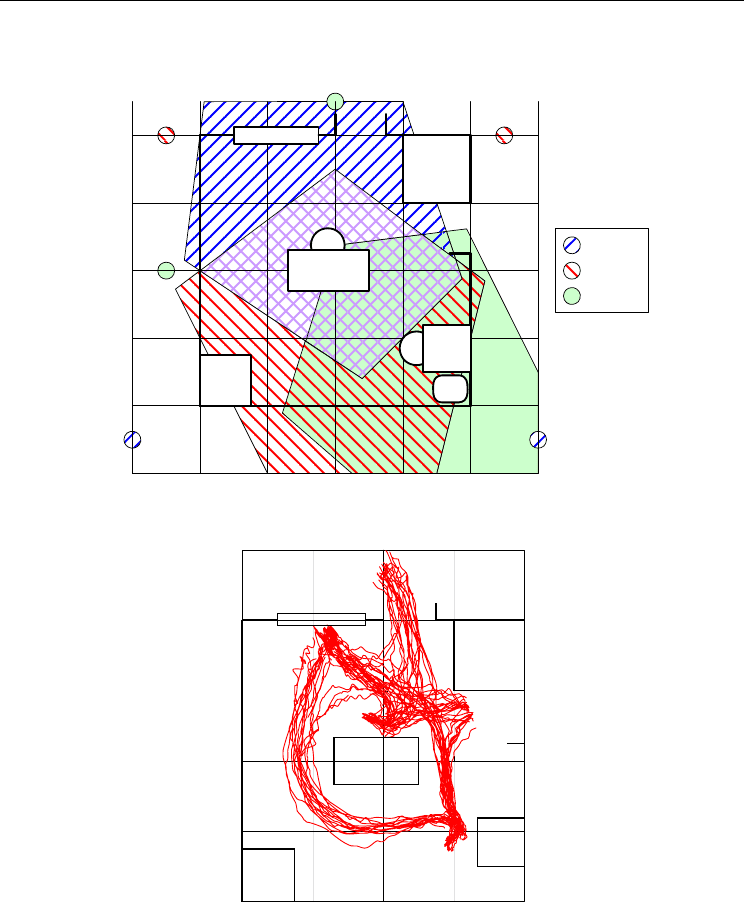
Intelligent Space as a Platform for Human Observation
319
by ǔ
v
=0.3m/s, k=20 and ǔ
d
=0.5m. This figure also shows some broken paths at the edges of
the environment. These results were influenced by the observable region of DIND.
0
0
12-1-2
-1
-2
1
2
-3
-3 3
DIND 1
DIND 2
DIND 3
x [m]
y [m]
Chair
1
Desk 1
Desk
2
Chair
2
Robot
Whiteboard
Figure 6. Experimental environment
-2
-1
0
1
2
3
-2 -1 0 1 2
x [m]
y [m]
Figure 7. Obtained human walking paths
5.2 Experiment of Extraction of Frequently Used Paths
First of all, important points are extracted to obtain frequently used paths. Important points
are defined by clusters including the points over 15% of the total at ǔ
c
=0.5m in both cases of
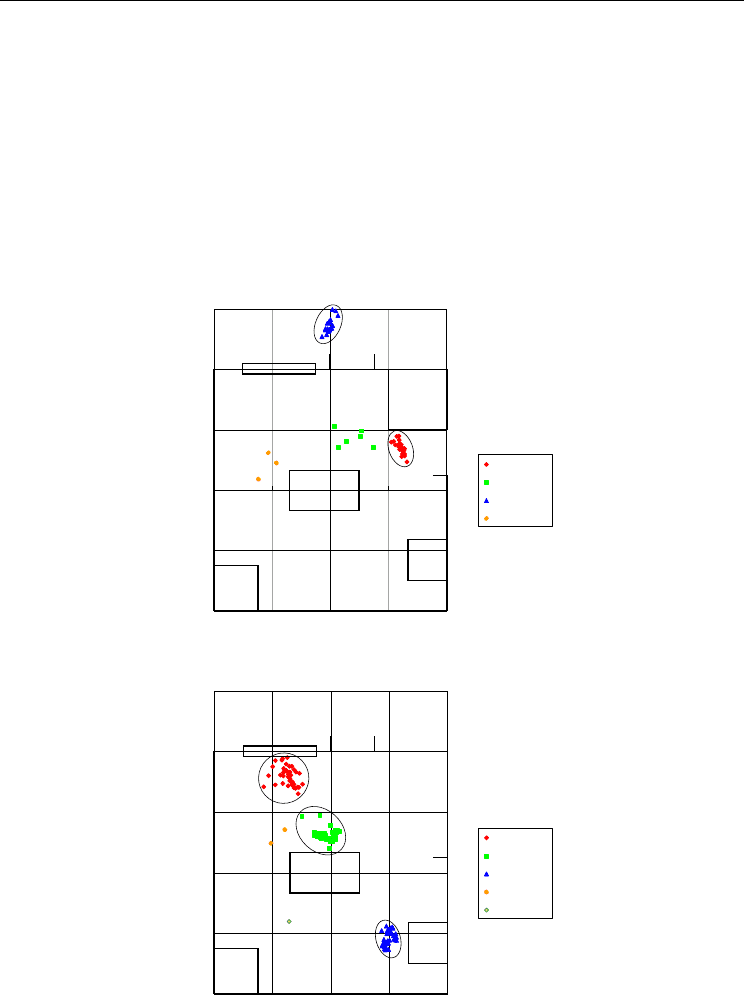
Human-Robot Interaction
320
entry/exit points and stop points. In addition, the distance between clusters is updated by
using the centroid method. Fig. 8 and Fig. 9 show the results of clustering. In these figures,
the clusters extracted as important points are indicated with ellipses.
In either case, the clusters that consisted of more than 30% of the total number of points
were formed and important points were extracted. However, there were some points
around Desk 1 that appeared as candidates for entry/exit points because of tracking
interrupts. The results were caused by unobservable occlusions because the flow of people
behind the Desk 1 was very intense. In order to solve the problem, in our future work
entry/exit points will not be determined by extraction based on clustering but preset based
on configuration of the space.
-2
-1
0
1
2
3
-2-1012
x [m]
y [m]
Cluster 1
Cluster 2
Cluster 3
Cluster 4
Figure 8. Extraction of entry/exit points
-2
-1
0
1
2
3
-2-1012
x [m]
y [m]
Cluster 1
Cluster 2
Cluster 3
Cluster 4
Cluster 5
Figure 9. Extraction of stop points
